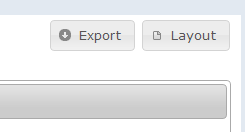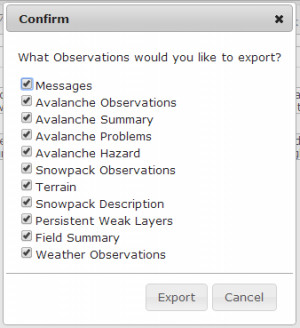Difference between revisions of "Downloading your own data"
Jump to navigation
Jump to search
(→Step-by-step description) |
(→Step-by-step description - Downloading from 'Download Operation Data' in the Cogwheel menu) |
||
| (8 intermediate revisions by 2 users not shown) | |||
| Line 2: | Line 2: | ||
{{Requirements|UserLevel=Operation Administrator and higher|Connectivity=Online only}} | {{Requirements|UserLevel=Operation Administrator and higher|Connectivity=Online only}} | ||
| − | This | + | This page describes how to download your own data from InfoEx for use in programs like Excel. |
==Background== | ==Background== | ||
| − | To allow operations to make better use of the data they have | + | To allow operations to make better use of the data they have submitted to InfoEx, exporting is available. The report tables are downloaded as individual CSV (commas delimited) files that can be read by programs like Excel or Numbers. These files can be used for local archiving, research projects and case studies or end of season reports. Data can be downloaded via the reports function or 'Download Operation Data' in the cogwheel menu |
| − | {{Note|It is only possible to download reports that only include data of your own operation. InfoEx data files that include multiple operations require permission from | + | {{Note|It is only possible to download reports that only include data of your own operation. InfoEx data files that include multiple operations require permission from each of the included subscribers and must be requested from the Canadian Avalanche Association|NoteWithImage}} |
See [[Downloading your location catalog as a KML file]] for information on how to download you own location catalog. | See [[Downloading your location catalog as a KML file]] for information on how to download you own location catalog. | ||
| − | ==Step-by-step description== | + | ==Step-by-step description - Downloading from reports== |
{|class="TblSteps" | {|class="TblSteps" | ||
| Line 20: | Line 20: | ||
|class="StepNum" | 2. | |class="StepNum" | 2. | ||
|Click on the location field above the tables and select your own operation in the operation tab of the location filter (see [[Restricting the locations included in an InfoEx report]] for more details. | |Click on the location field above the tables and select your own operation in the operation tab of the location filter (see [[Restricting the locations included in an InfoEx report]] for more details. | ||
| − | {{Note|It is only possible to | + | {{Note|It is only possible to export a report if your operation is the one and only operation in the location filter.}} |
|- | |- | ||
|class="StepNum" | 3. | |class="StepNum" | 3. | ||
| Line 32: | Line 32: | ||
|class="StepNum" | 4. | |class="StepNum" | 4. | ||
|Select the desired date range for your report by clicking on the date range field above the tables. Once you have selected the desired date range, wait for the data to appear. | |Select the desired date range for your report by clicking on the date range field above the tables. Once you have selected the desired date range, wait for the data to appear. | ||
| − | {{Note|If you have entered a lot of data into the InfoEx and you are querying the server for the entire season, you might not be able to download it all at once. If this happens, you can still download your information, but you will need to explicitly do it table by table. In other words, you will need to create individual reports with only weather observation, | + | {{Note|If you have entered a lot of data into the InfoEx and you are querying the server for the entire season, you might not be able to download it all at once. If this happens, you can still download your information, but you will need to explicitly do it table by table. In other words, you will need to create individual reports with only weather observation, field summaries, avalanche observations, ... and download them separately. See [[Specifying the tables to be included in an InfoEx report]] for more information on how to do this.}} |
|- | |- | ||
|class="StepNum" | 5. | |class="StepNum" | 5. | ||
| − | |[[File:ExportButton.png|300px|thumb|right|Fig. 1: Export button]] Click on the export button (Fig. 1) in the top right corner above the report tables. This button is only | + | |[[File:ExportButton.png|300px|thumb|right|Fig. 1: Export button]] Click on the export button (Fig. 1) in the top right corner above the report tables. This button is only available for operation administrators when your report only contains data from your own operation. |
|- | |- | ||
|class="StepNum" | 6. | |class="StepNum" | 6. | ||
| Line 41: | Line 41: | ||
|- | |- | ||
|class="StepNum" | 7. | |class="StepNum" | 7. | ||
| − | |[[File:ExportConfirmMultipleFiles.png|300px|thumb|right|Fig. 3: Confirm export of multiple files]] | + | |[[File:ExportConfirmMultipleFiles.png|300px|thumb|right|Fig. 3: Confirm export of multiple files]] If prompted, confirm in the yellow bar at the top of the browser window (Fig. 3) that you allow the site to download multiple files. |
|- | |- | ||
|class="StepNum" | 8. | |class="StepNum" | 8. | ||
|Open the downloaded files in a program like '''Excel''' or '''Numbers'''. | |Open the downloaded files in a program like '''Excel''' or '''Numbers'''. | ||
| + | |} | ||
| + | |||
| + | ==Step-by-step description - Downloading from 'Download Operation Data' in the Cogwheel menu== | ||
| + | |||
| + | {|class="TblSteps" | ||
|- | |- | ||
| − | |class="StepNum" | | + | |class="StepNum" | 1. |
| − | | | + | |Select your start and end dates. |
| − | + | |- | |
| − | + | |class="StepNum" | 2. | |
| − | + | |Select the tables you would like to download and click on {{ButtonBlue|Download}}. | |
| − | {{ | + | |- |
| + | |class="StepNum" | 3. | ||
| + | |A single csv file will be downloaded with all the data submitted by your operation. Open the downloaded file in a program like '''Excel''' or '''Numbers'''. | ||
|} | |} | ||
Latest revision as of 10:26, 1 June 2017
| REQUIREMENTS | |
| Permission | Operation Administrator and higher |
| Connectivity | Online only |
This page describes how to download your own data from InfoEx for use in programs like Excel.
Background
To allow operations to make better use of the data they have submitted to InfoEx, exporting is available. The report tables are downloaded as individual CSV (commas delimited) files that can be read by programs like Excel or Numbers. These files can be used for local archiving, research projects and case studies or end of season reports. Data can be downloaded via the reports function or 'Download Operation Data' in the cogwheel menu
| NOTE | It is only possible to download reports that only include data of your own operation. InfoEx data files that include multiple operations require permission from each of the included subscribers and must be requested from the Canadian Avalanche Association |
See Downloading your location catalog as a KML file for information on how to download you own location catalog.
Step-by-step description - Downloading from reports
| 1. | Start from one of the standard reports (Standard-Today or Standard-Yesterday). | ||
| 2. | Click on the location field above the tables and select your own operation in the operation tab of the location filter (see Restricting the locations included in an InfoEx report for more details.
| ||
| 3. | Adjust the report to your liking by
| ||
| 4. | Select the desired date range for your report by clicking on the date range field above the tables. Once you have selected the desired date range, wait for the data to appear.
| ||
| 5. | Click on the export button (Fig. 1) in the top right corner above the report tables. This button is only available for operation administrators when your report only contains data from your own operation. | ||
| 6. | Confirm the tables you would like to export (Fig. 2) and click on Export. | ||
| 7. | If prompted, confirm in the yellow bar at the top of the browser window (Fig. 3) that you allow the site to download multiple files. | ||
| 8. | Open the downloaded files in a program like Excel or Numbers. |
| 1. | Select your start and end dates. |
| 2. | Select the tables you would like to download and click on Download. |
| 3. | A single csv file will be downloaded with all the data submitted by your operation. Open the downloaded file in a program like Excel or Numbers. |
Related documents
Customizing reports
[1] Click to watch a help video
[2] Click to watch a help video
- Content
- Specifying the date or date range of an InfoEx report
- Restricting the locations included in an InfoEx report
- Specifying the tables to be included in an InfoEx report
- Adding or removing columns of individual tables in an InfoEx report
- Applying filters to individual tables in an InfoEx report
- Including or excluding proprietary information in an InfoEx report
- Layout
Managing report templates
- Saving a report as an InfoEx report template
- Modifying an existing InfoEx report template
- Deleting an existing InfoEx report template
- Signing up for the daily InfoEx report emails
Viewing report templates
Map Layers
- Operation overview
- Avalanche observations
- Avalanche hazard
- Snow Profiles
- Field summary
- Weather observations
- Time slider (used for all map layers)
- Additional external information sources
Charts
Functionality tested by
- Feb 5, 2014: Pascal Haegeli

